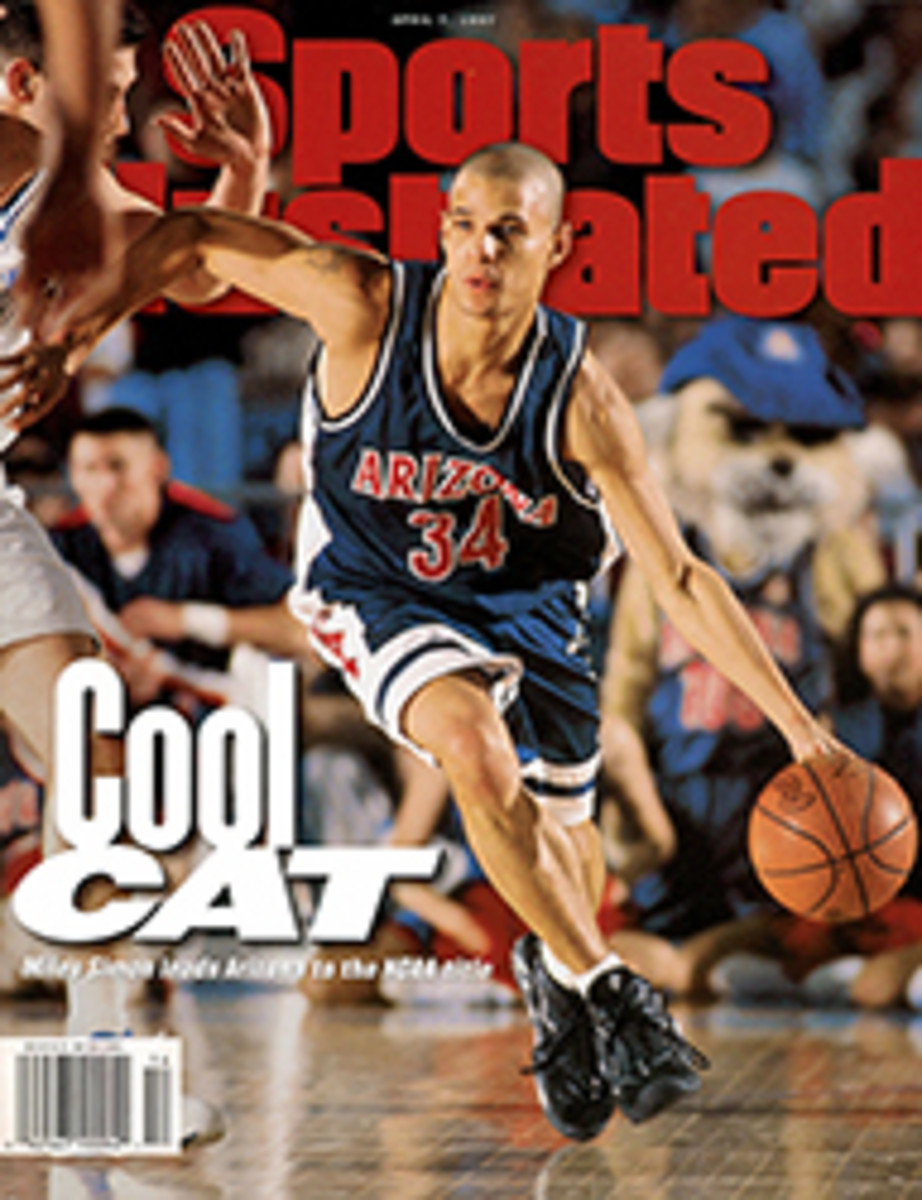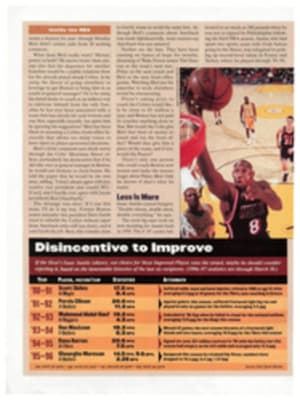
SAY YOUR PRAYERS AMEN CORNER MAY BE MORE FAMOUS, BUT A STRETCH ON THE FRONT NINE'S MORE DANGEROUS
It is Thursday morning, April 10, and our hero, the Masters
rookie, is off to a good start. With a solid par at the 1st hole
and a birdie at the par-5 2nd, he stands on the 3rd tee knowing
that if he can make another birdie or two on the next few holes,
his name will go up on the giant leader boards scattered around
the course. Poor fellow. Little does he know that immediately
ahead lies the potential for disaster. The next three holes,
with the benign-sounding names of Flowering Peach, Flowering
Crab Apple and Magnolia, were the most difficult three-hole
stretch at Augusta National last year. Call it the Hot Corner.
For many years the first three holes on the back nine--the 10th,
plus the first two thirds of the storied Amen Corner--played the
hardest statistically. If you've watched the Masters on
television, you know the holes well: the long, downhill 10th,
its green surrounded by majestic pines; the 11th, where Larry
Mize chipped in to beat Greg Norman in 1987; and the 12th, the
short but dangerous par-3 over Rae's Creek, scene of so many
disasters. "Three, 4 and 5 are every bit as difficult," says
Sandy Lyle, the 1988 champion. Phil Mickelson agrees. "You just
want to play for par and get out of there," he says.
If your only Masters experience comes from TV, you've never seen
the 3rd, 4th and 5th, owing to Augusta National's absurd policy
of treating the front nine like a leper colony. Why not join our
Masters rookie as he prepares to hit his drive? The 3rd hole, at
360 yards, is the shortest par-4 (along with number 7) on the
course and is deceptively easy-looking, but last year it was the
sixth-most difficult hole.
"It's at number 3 where the course starts to play mind games
with you," says Ken Venturi, who twice came within a stroke of
winning the Masters. "Here is a short hole with no water and
just one greenside bunker. Yet it's so difficult."
There are pines on the right, a cluster of bunkers on the left.
"I've seen players use everything from a driver to a long iron
off the tee," says Arnold Palmer. "The strategy is to leave
yourself a full shot--wedge, nine-iron, whatever--to the green.
Because the green's on a plateau and narrow, you must be able to
stop the ball. That's essential."
Sounds easy enough, but the green is fronted on the left by an
extreme upslope. "Leave it short and you're dead," says John
Cook. "The ball will spin back off the green and roll all the
way to the bottom." That happened to Nick Faldo last year in the
third round. When his recovery chip was also short and rolled
back 10 yards off the green, he wound up with a double-bogey 6.
The green has a definite right-to-left slant, so when the pin is
to the left, a shot played to the middle of the green will
trickle down toward the hole. However, the pin is usually to the
right on Saturday or Sunday, requiring a left-to-right cut shot,
something that can be extremely difficult if the Augusta breezes
are blowing from the left.
Gary Player, a three-time winner, tells this story: Years ago he
was sitting with Bobby Jones at the champions dinner. He told
Jones that when the pin was to the left, the hole was almost
impossible to birdie, since the green was only seven yards deep
at that point. Jones leaned forward with a devilish grin and
said, "You're not supposed to make birdie on 3. The hole was
designed for a 4."
For the last two years the 4th, a 210-yard par-3, has been the
toughest hole on the course, playing at an average of 3.35
strokes. In other words, every time three players tee it up, one
of them will bogey. Jones, a co-designer of the course, wanted
the hole to reflect the principles of the par-3 11th at St.
Andrews, the High Hole, with its famous Strath and Hill bunkers
guarding the front. It was there, in the 1921 British Open, that
Jones, a still immature and volatile 19-year-old, did something
he lamented the rest of his life. After 36 holes he was the
leading amateur, but he shot a hideous 46 on the front nine and
was about to triple-bogey the 11th when he picked up his ball,
tore up his scorecard and withdrew.
When Augusta National was designed, the 4th was penciled in for
a reasonable 180 yards, but it has played as long as 220 yards,
depending on the location of the tee, which is behind and to the
right of the 3rd green. For a number of years now, its length
has been 205 yards. Because the tee is elevated, it's exposed to
the swirling winds that make life so difficult for players. Most
use a two- or three-iron off the tee, but it was with a
four-iron that Jeff Sluman made a hole in one in 1992, the first
ever on the hole. Until then, the 4th had been the only hole on
the course never eagled.
Player says he had long felt the 4th was Augusta National's most
difficult hole and was delighted when recent statistics proved
him right. "The wind here is fiendishly deceptive," he says.
"Many years ago I was standing behind Ben Hogan on the tee. He
hit a three-iron and said, 'Perfect,' but the wind caught his
ball and it fell in the front bunker."
"That bunker is the most dangerous factor on the 4th," says Lee
Janzen. "It's huge, and if you're in it, you're faced with one
of the most difficult shots on the course because of the steep
wall in front."
The large, undulating green is about 20 feet below the tee, with
a definite slope from back right to front left. Far to the right
of the green, just inside the course's boundary, is a stand of
bamboo, a relic from the days when the property was a nursery
called Fruitlands.
The last of the treacherous trio, the 435-yard 5th, a par-4,
last year ranked as the fifth-most difficult hole. It is often
called "the forgotten hole" because all but the most hardy
spectators choose to skip it. From a position to the right of
the 3rd green, one can watch play at number 4 without moving.
From there it is only a short walk to the 6th green.
The 5th tee, along with the 4th green, is at the southwest
corner of the course, as far as you can get from the clubhouse.
The hole heads directly south from the 4th green, forming a
sharp corner. It is an uphill hole--another reason spectators
tend to avoid it--with the landing area for drives some 35 feet
above the tee and the green 13 feet higher than that.
In the earliest sketches of Augusta National, Alister Mackenzie,
the principle designer, had the famous Road Hole at St. Andrews
in mind when he plotted the 5th, except that it would be a
dogleg left, not right. It was to be a par-5, just as the Road
Hole was until the 1950s, but by the time course construction
had begun in 1931, the 5th had become a par-4. A cavernous
bunker penciled in to guard the front of the green never got
beyond the design stage.
The ideal drive hugs the left side of the fairway. "The key is
the tee shot," says Fuzzy Zoeller, the '79 Masters champion.
"There are two bunkers at the crook of the dogleg you must carry
and some trees to avoid, but it's a much shorter, therefore
easier, approach to the green from there, especially if the pin
is to the right."
Disaster awaits the bold driver if he hits his tee shot a bit
too far left. He can consider himself fortunate if his ball
catches a bunker. To the left of that is a forest of magnolias
and pines. "Hit in there," Jimmy Demaret once said, "and they
might not find you for three days." In recent years the club has
mercifully cleared out some of the foliage, but a shot in there
still means bogey at best.
Lanny Wadkins is more concerned with the approach, which
generally requires a middle iron. "No hole on the course demands
a more properly planned and properly executed second shot," he
says. Wadkins says this because the 5th green is as dangerous as
any on the course. A hump divides the green, and if the approach
winds up on the opposite side of that hump from the pin, three
putts are almost inevitable. There is a small bunker behind the
green, put there for the player's benefit, preventing approaches
that overshoot the green from rolling down a steep embankment.
Jones always suggested that the best way to play the hole was to
let the approach land short and run onto the green. However, the
first time he played the hole in competition he three-putted.
One year Sam Snead, 45 feet away, saw his first putt catch the
wrong side of the ridge, curl around and come right back to his
feet. Having learned the line the hard way, he tried the putt
again and sank it.
In 1995 Jack Nicklaus proved the best way to handle the 5th
green is to avoid putting at all. In the first round his
five-iron approach landed directly in the hole. "For a second no
one knew where the ball went, including me," he says. "Then
everyone started cheering."
Two days later he chose a seven-iron. His wife, Barbara, walking
with a friend, said, "It's too bad you weren't here Thursday.
You missed Jack's eagle." Whereupon Nicklaus's approach landed
on the green and rolled into the cup.
"The scary thing about those three holes," says Nick Price, "is
that you've got to play them early in the round, and you don't
quite know what swing you've got to play with that day. By
contrast, when you get to Amen Corner, you at least know how
you're hitting the ball."
And what of our Masters rookie? We wish him well and hope he
doesn't follow in the footsteps of Douglas Clarke, Dave
Eichelberger and Bill Campbell, trailblazers of a dubious sort.
History does not reveal how, but Clarke made an 8 at the 3rd in
1980, Eichelberger a 7 at the 4th in 1965 and Campbell an 8 at
the 5th in 1957, all record highs for a total of 12 over par.
They know it's easy to get burned on the Hot Corner.
COLOR ILLUSTRATION: ILLUSTRATION BY STEVEN STANKIEWICZ A promising round can make an early U-turn on the 3rd, 4th and 5th holes. [Diagram of 3,4 and 5 holes at Augusta National golf course]
COLOR PHOTO: BOB MARTIN Players like Norman know that the 4th has been the toughest hole on the course. [Greg Norman golfing]
COLOR PHOTO: RUSTY JARRETT Far from the clubhouse (upper left), 3, 4 and 5 ring two par-3s: the 6th and the watery 16th. [Aerial view of Augusta National golf course]

